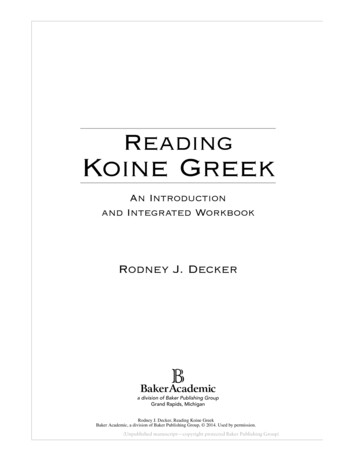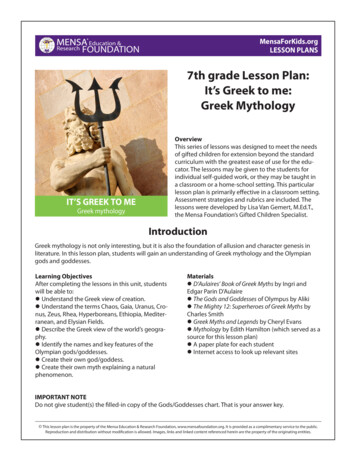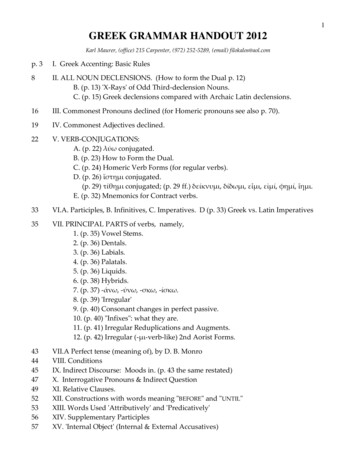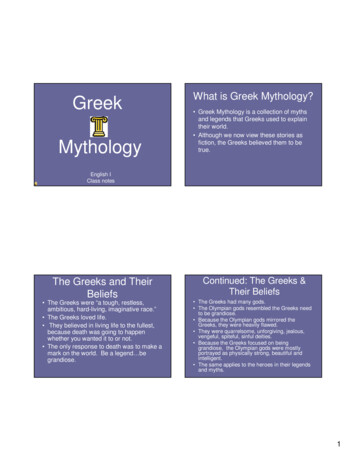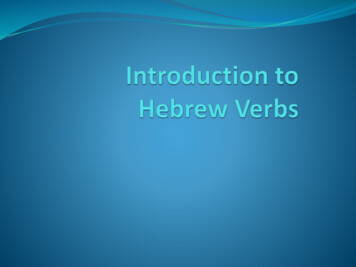
Transcription
Introduction to GreekTense Form ChoiceIn the Non-Indicative Moods(PDF Edition)S. M. Baugh, Ph.D.Professor of New TestamentWestminster Seminary California1725 Bear Valley ParkwayEscondido, CA 92027www.wscal.edu
Introduction to Greek Tense Form ChoiceIn the Non-Indicative Moods (PDF Edition)Copyright 2009 by Steven M. BaughAll rights reserved.This work is distributed as a PDF computer file (“PDF Edition”). Permission is granted toredistribute electronically the unmodified and complete computer file that comprises the PDFEdition of this work. This permission does not impair or restrict the author’s moral rights, orgrant any additional permissions. Without the prior written permission of the copyright ownerany or all of the following is not permitted: (i) altering, editing, or otherwise modifying the filethat comprises the PDF Edition of this work; (ii) selling, retailing, or offering in exchange forany kind of compensation the file that comprises the PDF Edition of this work or any of itscontent; (iii) redistributing some or all extracted or excerpted content from this work except asspecified below; (iv) redistributing some or all content of this work in a different format (forexample but not limited to HTML or plain text).Copying and distributing the PDF Edition in its original form as a PDF computer file or inprinted form for instructional or classroom use is hereby granted without obligation to contactor to seek permission from the copyright owner.All translations are the author’s unless otherwise indicated.Essential and extensive use of the GRAMCORD computer concordance (www.gramcord.org)and of the Thesaurus Linguae Graecae of the University of California, Irvine(http://www.tlg.uci.edu/) is gratefully acknowledged.ii
ContentsPAGEPREFACE.ivSYNOPSIS .v1.INTRODUCTION. 12.INFINITIVES . 153.SUBJUNCTIVES . 284.IMPERATIVALS . 365.PARTICIPLES . 496.MISCELLANEOUS . 65APPENDIX ONE . 69APPENDIX TWO . 71iii
PrefaceSince this material attained its written form some ten years ago, I have had occasionalthoughts about either publishing it as a series of journal essays or reworking it into a fullfledged book. I began the journal essays a couple of times, but other more urgent projectsalways intervened. It has finally dawned on me that this project will never go any farther than itis now—at least by me; I simply have too many other writing projects stretching off into thedistant horizon. I am, therefore, distributing this manuscript as a PDF file in the hopes that itwill be useful to students of Greek and particularly of the Greek New Testament.Let me clarify here that this work was not written primarily for other scholars—it is aninstructional manual written for first-year Greek students at our seminary. Furthermore, Iwrote this work in 1999 and though I have read subsequent literature on the subject, I have notupdated the footnotes in order to reflect this literature. I just don’t have the time now, and inthose ten years I have not read anything that has caused me to change my fundamental outlook.Most importantly, the reader should know that this work is certainly not the last wordon Greek verbal aspect. I view this as a starting point with a method for analysis of Greek verbsthat holds much promise. It may contain minor misjudgments on particulars, but I think itgives beginners in Greek a fair and relatively accurate starting point for their own analysis ofGreek verbal aspect as they move forward with their own work.Finally, the main research for this work was conducted during a study leave generouslygranted by the Board of Trustees of Westminster Seminary California allowing me to surveyGreek literature from Xenophon to Athanasius and non-literary works (papyri and inscriptions)in order to corroborate my ideas. Our board is always most generous and supportive and theyhave my genuine thanks here.sola Christi gratia.Westminster Seminary CaliforniaEscondido, CA, USAiv
SynopsisThe approach to Greek verbs taught here has several distinctive elements that areoutlined as follows. Many terms used throughout the work are defined in the introductionchapter (pp. 7–8).1.This work focuses on the Greek non-indicative mood verb forms only, not the indicativemood.2.Tense form choice refers to the factors involved when a speaker or author chose a tenseform (present, aorist, perfect) to employ on a particular occasion.3.Each non-indicative mood must be evaluated on its own terms with its own series offactors influencing tense-form choice.4.To make global statements about a tense-form’s value which spans the various moods(e.g., the aorist is normally “punctilliar” in meaning) is problematic and has contributedto the lack of consensus in studies of Greek verbs.5.The previous point is particularly problematic when comparing indicative mood tenseform choice with the non-indicative moods.6.The vast majority of tense forms chosen by Greek speakers and authors were theexpected (“default”) form with minimal or no semantic value beyond the meaning of thelexeme itself.7.The previous point means that students should focus on the factors directing a speakeror author to choose one tense form over another in a given situation, because only thenwill the exceptions to what was expected with interesting semantic value stand out andbe more certain to be demonstrably correct (present as conative, aorist as inceptive,etc.).8.When a New Testament author expressed a nuance with a tense form rather than usingthe default form, later scribes sometimes wrote the expected form confirming theanalysis that the form of the original text has aspectual value.9.My work does not challenge the traditional understanding of the range of meanings ofthe various tense forms (e.g., present as conative, aorist as inceptive) but ratherconfirms it and helps students know when such meanings were being communicated byancient authors.10.This study is a starting point for entry level students of Greek not the last word on thesubject.v
CHAPTER ONE:IntroductionOrientationThere are many places in the Greek New Testament where the exact significanceof verbal tense forms continues to attract the interest of interpreters.1 Admittedly thisinterest sometimes draws interpretations which are far too simplistic despite warningsto the contrary. Classic cases of this usually involve an interpretation of present tenseforms as representing “continuous” or “linear” action and aorist forms as representing a“once for all” or “punctilior” kind of event.2 In contrast, while considering three passageswhere various tense forms are found in verbs of various moods (1 Pet. 2:17: John 7:24;15:16), G. C. Neal cautioned against this type of oversimplification:There are many factors which might have led a Greek writer to choose oneor other tense of these moods of the verb. Certainly one of them mighthave been the analogy of the imperfect and aorist tenses of the indicative. . . But considerations of euphony, the predominant tense of the passage,differences in style, and other criteria could have had equal weight. To agreat extent also I suspect the choice was arbitrary.3Let me illustrate Prof. Neal’s point with these three New Testament passages. kre tton g r stin gamÐsai puro sqai, “for it is better to marry than to burn(with passion)” (1 Cor. 7:9; NIV). l sate a tªn ka f¡rete, “Untie it [a donkey colt] and bring it here” (Mark 11:2) n chte p stin ka mÏ diakriqÐte, “If you have faith and do not doubt. . .”(Matt 21:21).1Theterm “tense form” will be used here for the Greek present, aorist, perfect, etc. forms. Thisterm does not imply that tense or the time of a verb’s occurrence is necessarily expressed by theseforms.examples and critique see: Charles R. Smith, “Errant Aorist Interpreters,” Grace TheologicalJournal 2 (1981): 205–26; Randy Maddox, “The Use of the Aorist Tense in Holiness Exegesis,”Wesleyan Theological Journal 16 (1981): 106–18; Frank Stagg, “The Abused Aorist,” JBL 91(1972): 222–31; D. A. Carson, Exegetical Fallacies (Grand Rapids: Baker, 1984): 69–77. NewTestament commentaries are full of verbal aspect oversimplification as the previous articlescatalogue; see also Ronald Ward, Hidden Meaning in the New Testament (Old Tappan, NJ:Fleming H. Revell, 1969).2For3Neal,“In the Original Greek,” Tyndale Bulletin 12 (1963): p. 13.1
IntroductionAs you can see, the authors in these verses alternate between present and aorist forms inthe same context in parallel constructions. They chose different tense forms for somereason. Why?I find Neal’s suggestions that an author chose a particular tense form because ofeuphony or because of his style very suggestive, and I readily heed his caution and thewarnings of others against oversimplification of the Greek tenses. But we study theGreek of the New Testament to find “nuggets” of interpretation, and Greek tense formshave been a very profitable mine for us to date. To think that “to a great extent” thechoice of tense form could be arbitrary would be, to say the least, bothersome if true.What other points of Greek grammar are merely arbitrary as well? And what are these“other criteria” which might govern tense form choice? And even more basic, how do weknow when the choice was arbitrary making the form itself semantically insignificantand when was it not?Subsequent study in the area of Greek verbal aspect led me further into thesekinds of questions focusing on tense form choice itself (rather than on questions ofverbal aspect proper—a more common subject of discussion). What are the factorsgoverning an author’s choice of forms? The answer to this question is not simple,because Greek is not simple as we will see. And in the following analysis, I have notconsidered matters like euphony and style adequately yet which would complicatematters even more. My original intent is to provide first year Greek students with both adescription of the Greek verb system and a procedure for making thoughtful analyses ofverb forms. In this light, this essay is a step toward fulfilling that intent. I am notfinished yet. However, I have finally arrived at a place where I can say a few things withsome confidence as to their reliability and usefulness in the exegetical enterprise.BackgroundBefore explaining my findings, let me give some relevant background into currentdiscussion on Greek verbal aspect. As in so many areas of scholarship, there is ananimated debate today over the proper analysis of the ancient Greek verb system, whichcan do nothing but bring our understanding of this vital subject into sharper focus. Themain participants include Buist Fanning, K. L. McKay, and Stanley Porter.4 The debateitself is mostly theoretical and centers on the relationship of verbal aspect, tense proper,and the various Greek verbal “tense forms.” Despite disagreements, most debateparticipants would define the key term aspect in a similar way as the manner in whichM. Fanning, Verbal Aspect in New Testament Greek (Oxford: Clarendon, 1990); K. L.McKay, A New Syntax of the Verb in New Testament Greek: An Aspectual Approach, (Studies inBiblical Greek, 5; New York, Bern, et al.: Peter Lang, 1994); idem, “Time and Aspect in NewTestament Greek,” NovT 34 (1992) 209-28; Stanley Porter, Verbal Aspect in the Greek of theNew Testament (Studies in Biblical Greek, 1; New York, Bern, et al.: Peter Lang, 1989); idem,Idioms of the Greek New Testament (Sheffield: JSOT, 1992). See also: Albert Rijksbaron, TheSyntax and Semantics of the Verb in Classical Greek: An Introduction, 2d ed. (Amsterdam: J. C.Gieben, 1994); Peter Stork, The Aspectual Usage of the Dynamic Infinitive in Herodotus(Groningen: Bouma’s Boekhuis, 1982); B. Comrie, Aspect. An Introduction to the Study ofVerbal Aspect and Related Problems (Cambridge Textbooks in Linguistics, 2; Cambridge: CUP,1976).4Buist2
Introductionthe Greek speaker or writer represents an event.5 The term “description” has beenhelpfully suggested as a more meaningful and accurate term in place of “aspect.”Regardless of the term used, though, aspect must be distinguished from how the eventoccurs historically.6Differences over Greek verbal aspect today may be exemplified by the variancebetween Stanley Porter’s and Buist Fanning’s approaches.7 Porter follows a model of“systemic linguistics” where aspect is described in a unified and prescriptive model.8 Inhis view, Greek tense forms grammaticalize only aspect; tense itself is communicated inGreek by contextual factors, not morphologically. Furthermore, Porter says that thepresent tense forms are more “marked” than aorist forms, which are less marked or“unmarked” throughout the Greek verb system.9 The “stative” aspect (perfect andpluperfect forms) “is the most heavily weighted” and hence has the most semanticvalue.10In some ways, Buist Fanning’s work resembles Porter’s. Both are informed bymodern linguistics and both are exploring Greek with a common notion of what verbalaspect means. However, Fanning focuses much more attention on the variety of factorswhich influence the interpretation of verbal aspect. As a result of this, Fanningaddresses the inherent meaning of verbs in particular to show how patterns of usage canbe found and predicted for verbs with particular kinds of meaning. Fanning, followingcertain linguists, divides events into categories which each sub-divide in a way which5Iuse “event” to refer to any action or state to which a verb form may refer. See the definitionbelow. “Tense” refers to the time of an event’s fulfillment; either absolutely in respect to thewriter’s time frame, or relative to that of a lead verb; cf. Wallace, Greek Grammar Beyond theBasics (Grand Rapids: Zondervan, 1996) 497–98.term Aktionsart(en) is frequently invoked at this point to refer to the “objective” fulfillmentof an action or state; however, I do not use this term for reasons which will be explained later.6The7Fora convenient collection of essays summarizing part of the debate see: Stanley E. Porter andD. A. Carson, eds., Biblical Greek Language and Linguistics: Open Questions in CurrentResearch (JSNTSS, 80; Sheffield: Sheffield Academic Press, 1993).8D.A. Carson says that Porter’s system is virtually immune to criticisms of his interpretation ofparticular data; see “An Introduction to the Porter/Fanning Debate,” in Biblical Greek Languageand Linguistics, p. 24. However, any theory which is exempt from adjustment or even outrightrefutation from data is given too much personal privilege. See K. L. McKay, “Time and Aspect,”for thoughtful criticism of Porter’s work.9Porterexplains these terms in a glossary: “Marked and unmarked: labels given to variousconstructions to imply their relative semantic weights. The unmarked structure is often morefrequently found, more diverse in form, less regular in structure, of less formal substance, lessemphatic and of minimum essential meaning. The marked structure is often less frequent inappearance, more stable in form, more regular in structure, of greater formal substance, moreemphatic, and of greater significance in meaning” (Idioms, pp. 311–12). Compare default formsdiscussed below.in Idioms, p. 22. The examples Porter gives for this interpretation range across thevarious moods. A central approach of this paper is that markedness (or “default forms”) variessignificantly in the different moods and in different linguistic situations.10Summarized3
Introductionseems too theoretical to be of practical value to some.11 However, in my view the value ofFanning’s division is not in the particulars or in the subtleties of his categories, but inthe point that lexis plays a fundamental role in verb form choice. Fanning writes:[F]ully subjective choices between aspects are not common, since thenature of the action or the procedural character of the verb or verb-phrasecan restrict the way an action is viewed by a speaker. In fact, aspectinteracts so closely with such features and is so significantly affected bythem that no analysis of aspect can be fully meaningful without attentionto these interactions.12Porter’s criticism of Fanning focuses on this point. He writes: “Tense usage is notdependent upon lexis, otherwise there is no accounting for the number of different tenseforms in Greek that may be used with the same lexical item within the same temporalcontexts.”13 Porter faults Fanning for what he thinks is theoretical confusion, primarily,he says, because Fanning’s method compromises the coherent interconnection of theaspects his own systemic approach identifies (or creates).14I do not wish to review this debate any further nor to interact explicitly with its concernsin any detail in this work for various reasons. In part it is because I am not a truepartisan. My own theoretical framework resembles Fanning’s more than Porter’s, yet Ihave learned and adopted much from Porter and many other scholars to whom Igratefully acknowledge my debt. Their work has been immensely helpful.Another reason that I am not joining the verbal aspect debate directly is that I amnot trying to develop a theoretical model of Greek verbal aspect here. I am working inwhat linguists call “pragmatics”; an analysis of how the language works in light of theinterconnection of all factors in specific contexts. From this, I have developed principlesto guide Bible interpreters in the evaluation of certain forms in various contexts byasking the simple, guiding question, “What factors influenced the author to choose thisform in this context?” In my opinion, the question of tense form choice which I addresshere is one which should properly be asked before (or at least alongside) theMcKay, New Syntax, p. 29, n. 1. See Fanning, Verbal Aspect, p. 129 for a graphic overviewof these categories (states—actions activities—performances, etc.).11E.g.,12Fanning,Verbal Aspect, p. 85.Verbal Aspect, p. 87. Interestingly, in the same work Porter calls for the evaluation ofthe role of lexis in verbal aspect in several places (pp. 87; 96–97 and 184), but he does notdevelop this thought.13Porter,14Inmy understanding, what drives Porter’s work and his criticism of Fanning is his search for aperfectly coherent system within Greek verbal aspect “with all the working parts functioningtogether” (Porter, “In Defense of Verbal Aspect,” in Biblical Greek Language, p. 45). However, Isimply believe that living languages are full of inconsistencies which defy perfectly symmetrical(or systemic) modeling—imperfect modeling perhaps! The Greek of the New Testament inparticular, with its variegated history and influences, is full of such inconsistencies and caprices.This comes out particularly in the fact that I do not agree with Porter, for example, that the aoristis the “unmarked” or less marked verb form across the board. The aorist is marked in someconstructions and contexts, but not in others. See below for discussion of how this bears onGreek infinitive usage.4
Introductiondevelopment of a general theory of Greek verbal aspect. The thesis—really, the theses—of this paper may support one theory or another, but for now I simply hope to establishthe accuracy of my analysis, which, I find, is of immediate and important help forexegetes who are wrestling with the significance of a particular verbal tense form in aparticular context.Put succinctly, my central concern revolves around the discovery of the factorswhich influenced an author’s tense form choice in the non-indicative moods. Thisrequires that we detect the grammatical system (“langue,” Saussure) which guided anauthor’s choice of tense form in a particular situation, including those places where noset form was required. As far as I have found, this issue has not been investigatedextensively by any of the participants in the current debate themselves nor by otherGreek scholars.15 But it deserves focused attention.16Groundwork and AssumptionsIt is best to explain certain presuppositions and to define some terms beforegoing further. First, I will here discuss tense form selection factors for the Greek nonindicative moods only: the infinitive, subjunctive, imperative, participle, and optativemood forms.17 The indicative mood must be analyzed along different lines at least partlybecause of the interference of the factor of tense. In my opinion, most of the work inverbal aspect to date applies most directly to the indicative, and only indirectly to thenon-indicative moods. Hence, the following is one of my key working assumptions andis well supported by the evidence: each mood must be treated separately as operatingaccording to independent, though analogous sets of principles affecting tense formchoice.18 Failure to treat the various moods discretely has led to assertions about tense15Thisdoes not mean that scholars are unaware of the issue. For example, see Porter’s definition:“Greek verbal aspect is a synthetic semantic category (realized in the forms of verbs) used ofmeaningful oppositions in a network of tense systems to grammaticalize the author’s reasonedsubjective choice of conception of a process” (Verbal Aspect, p. 88; emphasis added). AndFanning’s work does address this point indirectly, but at length. Stork’s Aspectual Usage doesaddress the idea of tense form choice in Herodotus.16Noteespecially the remark by Moises Silva: “Neither Fanning nor Porter takes sufficientaccount of the fact that, quite frequently, aspectual choices may be greatly restricted by a varietyof factors, such as the grammatical system itself” in “A Response to Fanning and Porter on VerbalAspect,” in Porter and Carson, Biblical Greek Language and Linguistics, 74–82; quote from p.79. My efforts here attempt to uncover such “variety of factors” in the Greek “grammaticalsystem.”17Wewill only discuss the optative in passing, because it is relatively rare in the New Testamentand follows easily understandable lines. For the sake of brevity I will refer to the Greek infinitiveand participle as moods here, although they technically do not qualify as such. I will generally useolder terminology found in standard grammars merely to accommodate to the terms with whichmost people are still familiar.18For example, in one short verse we find three tense forms in four forms: Wste dokçn[present] st nai [perfect] blep¡tw [present] mÏ p¡sÑ [aorist] (1 Cor. 10:12). In my analysis, eachthese forms conforms to standard lines of usage for its mood. Paul is not just choosing formsarbitrarily.5
Introductionand aspect which are undercut, in my mind, by examples drawn indiscriminately fromthe various moods without careful consideration of the factors influencing the tenseform selection process for each particular mood.19 In short, we must analyze Greekmoods separately in any discussion relating to verbal aspect. The main purpose of thispaper is to present the underlying principles guiding tense form selection in the NewTestament for each non-indicative mood.Secondly, I assume that the inherent lexical meaning of a verb sometimes plays akey role in tense form choice. As the sketch of the current debate above indicates, I amindebted to Buist Fanning’s work for this idea. My exact schema, however, does utilize amore simplified taxonomy of inherent meanings as will be discussed shortly.Thirdly, we are dealing with elements of the grammatical structure of the Greeklanguage and therefore with features which do not easily change over time. In contrast,for instance, lexemes in any language may experience metasemasia (changes inmeaning) relatively quickly.20 This means that even when we take stylistic, personal,regional, or dialectal variance into consideration, we should be able to discern the samefactors influencing Greek tense form choice throughout the ancient period, not just inthe New Testament period. Neither I nor anyone else has done a thorough, statistical jobin this area yet; however, my reading in Greek authors from Xenophon (fourth centuryBC) to Athanasius (fourth century AD) have convinced me of the general reliability of myapproach so far.21Fourthly, I should also mention that I am dealing almost exclusively here with thepresent and aorist forms of the various non-indicative moods—the perfect and futuretense forms will receive only cursory treatment at the end. The present and aorist“tenses” account for the vast majority of non-indicative tense forms of interest and standin bipolar opposition in the structure of the Greek verb system. For example, the 38perfect and 5 future infinitives in the New Testament compare with over 2,000 instancesof the present and aorist infinitive forms.Finally, the terms which need definition follow in alphabetical order.19Forexample, J. W. Voelz is particularly susceptible to this in his essay: “Present and AoristVerbal Aspect: A New Proposal,” Neotestamentica 27 (1993) 153-64.20Easy sources for examples in this regard are the original King James and the New King Jamesversions (which correspond in time separation about as much as Xenophon does with Paul). Wefind the same basic syntax operating in both translations even amidst so many lexicaldifferences. E.g., “Now as touching things offered unto idols, we know that we all haveknowledge. Knowledge puffeth up, but charity edifieth” (KJV); “Now concerning things offeredto idols: We know that we all have knowledge. Knowledge puffs up, but love edifies” (NKJV) (1Cor. 8:1).work of Peter Stork (“Aspectual Usage of the Dynamic Infinitive in Herodotus”) is ofparticular interest in this regard. I also should note that future work in the LXX in connectionwith tense form choice will be quite important, despite the fact that the various translators showsuch wide variance in their facility with tense form choice factors. This element in Greek, beingrather subtle and not represented in Semitic languages, undoubtedly took a considerable amountof time to master. Some LXX translators did not seem to have done very well in this regard (e.g.,Joel).21The6
IntroductionArgument: Elements in a statement which compose information essentialto the full expression of a verb form. For instance, a clause making upindirect discourse is the “argument” of the lead verb of communication.Aspectual Nuance (or just Nuance): The tense form when it is not defaultand is therefore “marked,” communicates a nuance of verbal aspect. Thesenuances are the ideas covered in most standard treatments of Greek verbs;for instance, for the present stem forms: customary, conative, inchoative,or progressive action; for the aorist stems: inceptive (or ingressive), simple(or “complexive”), and consummative action.22 This paper does not addanything new to the analysis of verbal aspect proper, so one should read italong with the standard treatments. Here we are solely concerned with thequestion: How can we know that these nuances were intended by a Greekauthor in a particular statement?Default Forms: The tense form endorsed by the conventions of Greektense form usage. The specific conventions influencing tense form choiceare the subject of this essay. This concept is nearly synonymous with theterm, the “unmarked” form (in opposition to the “marked” form) as longas one understands that the “markedness” of forms varies in differentlinguistic situations and that there may even be varying degrees ofmarkedness.23Event: Any state, relationship or action to which a verb form refers.24Events can be broadly sub-divided into atelic and telic events (see below).Lexeme: The basal form of a word considered without reference to itsvarious morphological transformations. Similar to the common term“lexical form,” though, technically, a lexical form also serves as an inflectedform. Hence, sample verbal lexemes are: b llw, rcomai, cw, d dwmi,fob¡omai, ktl.Lexical Determination: When a verb is missing particular tense forms, itsrealizations in the only form possible are said to be lexically determined.For instance, e nai is lexically determined because no aorist or perfectforms exist in the NT for the infinitive of e m (even though g¡nesqai mightbe appropriated as this verb’s virtual aorist form).22See,23Seee.g., Wallace, Greek Grammar, 513–86.Porter’s definition of marked forms given in note 9 above.24Thereis no satisfactory term in English for this concept. Compare Rijksbaron’s “states ofaffairs” as “a cover term for ‘that which is expressed by a predication’ ( roughly: a verb form andits arguments, e.g., subject and object)” in Syntax and Semantics, p. 3, n. 4. The verb’s“argument” (complements or other essential components) may also be included as the referenceof my term event.7
IntroductionLexical Factor: The inherent character of the event referenced by a verbform. The older term Aktionsart (German, “kind of action”) approximatedthis idea, but it has been defined so differently by different scholars that Ino longer use it.Realization: The expression of a verb form with all its attendant parts in acontext
4Buist M. Fanning, Verbal Aspect in New Testament Greek (Oxford: Clarendon, 1990); K. L. McKay, A New Syntax of the Verb in New Testament Greek: An Aspectual Approach , (Studies in Biblical Greek, 5; New York, Bern, et al.: Peter Lang, 1994); idem , "Time and Aspect in New


